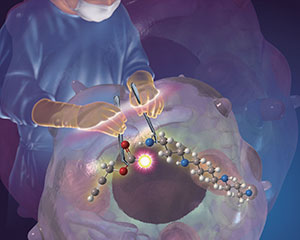Sep. 8, 2017 Research Highlight Medicine / Disease
Labeled propargyl esters promise to help diagnose and treat tumors
A selective chemical reaction that spotlights cancer cells could also facilitate precisely targeted treatments
 Figure 1: The ability to label propargyl esters (molecule on right) with fluorescently tagged propargyl ester probes (molecule on left) opens up new possibilities of imaging, and even attacking, cancer cells. Reproduced from Ref. 1 with permission of The Royal Society of Chemistry
Figure 1: The ability to label propargyl esters (molecule on right) with fluorescently tagged propargyl ester probes (molecule on left) opens up new possibilities of imaging, and even attacking, cancer cells. Reproduced from Ref. 1 with permission of The Royal Society of Chemistry
One of the key challenges in fighting cancer is finding agents that attack tumor cells without causing collateral damage to adjacent healthy tissue. By building on a chemical strategy that labels a family of molecules involved in cell proliferation, RIKEN researchers have found a way to tag—and potentially kill—cells engaged in cancerous growth1.
While studying a class of compounds called propargyl esters, Katsunori Tanaka, head of the RIKEN Biofunctional Synthetic Chemistry Laboratory, found that they exhibited a surprisingly strong propensity to attach to cellular biomolecules known as polyamines. Scientists are interested in polyamines because they appear to play a prominent role in driving cell division, although their specific mode of action is poorly understood.
“Polyamines are present in higher concentrations near tumors,” explains Tanaka. “Furthermore, previous studies have shown that cancer cell growth can be arrested by knocking out the genes responsible for the biosynthesis of polyamines.”
Tanaka, Kenward Vong and colleagues investigated whether the reaction between propargyl esters and polyamines could be exploited to detect cancer cells. In preliminary tests, they demonstrated that a fluorescently tagged version of their propargyl ester probe efficiently attached itself to various polyamines, achieving maximum labeling within a couple of hours. Importantly, the probe did not label other biomolecules containing similar chemical groups, such as the amino acid lysine—a critical feature for avoiding false-positive signals from healthy cells. “This degree of selectivity has never been seen in the literature before,” notes Tanaka.
Next, the researchers engineered their fluorescent propargyl ester probe to make it both soluble in water and able to penetrate cell membranes. This probe consistently produced a strong fluorescent signal in three different breast cancer cell lines, whereas no such labeling occurred in healthy breast and non-breast-derived cells. This is both in keeping with previous findings that breast cancer cells contain sharply elevated levels of polyamine compounds and it confirms that chemically related molecules remain unmodified in noncancerous cells.
This highly selective labeling could be useful both for research and diagnosis, and Tanaka and colleagues are now testing to see whether their probes work equally well in other cancers. If they do, he envisions powerful therapeutic possibilities for compounds based on propargyl ester. “There are possibilities to develop anticancer therapies that rely, for example, on sequestering polyamines,” says Tanaka. “Due to the importance of polyamines in cancer cell growth and proliferation, there should be many avenues for our group to explore.”
Related contents
- The deadly toxin acrolein has a useful biological role
- Glycocluster design could lead to targeted drug delivery
- A golden opportunity for drug targeting
References
- 1. Vong, K. K. H., Tsubokura, K., Nakao, Y., Tanei, T., Noguchi, S., Kitazume, S., Taniguchi, N. & Tanaka, K. Cancer cell targeting driven by selective polyamine reactivity with glycine propargyl esters. Chemical Communications 53, 8403–8406 (2017). doi: 10.1039/C7CC01934C
